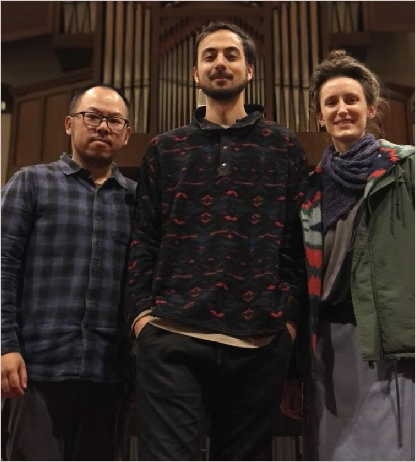Another Timbre TimHarrisonbre

at190 Johnny Chang & Keir GoGwilt ‘hope lies fallow’
A series of pieces by violinists Johnny Chang and Keir GoGwilt, developed from early music works by Hildegard van Bingen and Orlando di Lasso.
With Celeste Oram on vocals on three of the tracks.
1 ‘hopes to adjust’ 9:20
2 ‘Cantigas: Hildegard’ 10:11 Youtube extract
3 ‘beatific creatures’ 7:37
4 ‘Interlude’ 18:05
5 ‘who follows me’ 11:20
6 ‘Hildegard Resonances’ 18:04
Recorded at MacLaurin Chapel Auckland / Tāmaki Makaurau, New Zealand Aotearoa
Juy 2021
CD copies sold out, but downloads available here
Interview with Keir GoGwilt
How - and where - did your collaboration with each other come about?
KG: I spent
a year in Auckland/Tāmaki Makaurau with my partner, Celeste (who sings on this album),
from September 2021 to August 2022. Johnny had also just moved back to Aotearoa New
Zealand from Berlin - we connected and started meeting up every week to play together.
Our first session was in Johnny’s backyard in Orewa; we kept shaping the material
through some presentations at the Audio Foundation, Auckland University, the Pyramid
Club (together with taonga puoro musician Rob Thorne), and MacLaurin chapel (joined
by Celeste and Blake Scanlen).
JC: My collaboration with Keir coincides with two instances of ‘coming around’. First, my return to New Zealand after living in Los Angeles and Berlin between 2000 and 2019. Secondly, re-centring my musical focus on the violin after a long period of distancing and building my listening around the viola. I am grateful to Keir for inspiring me to renew the connection to my first instrument with a stronger body and more open ears.
Why did you decide to ground your collaborative project in early music, and why Lassus and Hildegard?
KG: I’m drawn to working with early music because it turns the act of composition into a sort of musical archaeology. That is, we were both interested in really experiencing the world of these historical pieces in as textured a way as we could. Given our musical practices, this meant using the tools available to us: repetition, variations of timbre, the extension of measured sequences into unmeasured fantasies. Being creative with the music – or rather filtering it through our own idiomatic sensibilities – made it more vivid for us.
Johnny and I began playing de Lassus’ two-part motets for the simple reason that I found them while looking through sheet music downloaded on my tablet. I think Celeste had been singing them with friends in San Diego, outside in the park, at the outset of the pandemic. Reading through these pieces quite loosely and improvisationally, we began to tease them apart, repeating sequences in contrary motion, losing ourselves in ornamental meanderings, or expanding dissonant phrases to prolong our enjoyment of their inexorable cadences. As though these gestural, quasi-melismatic features were buried in de Lassus’ own historical memory all along.
JC: A few years ago I was introduced to the idea of hearing the music of Hildegard
von Bingen alongside modern music by German singer Irene Kurka, an active performer
of contemporary and experimental music. The sense of space inherent in Hildegard’s
music drew me in with many questions and inviting concepts. Additionally, I identify
fully with the notion of musical archaeology as an analogy for unearthing potential
soundworlds embedded within each score.
Are each of the pieces composed by one of you, or is there an element of collaboration in the process of composition?
KG: I would say all the pieces on this CD are collaborative, though the creative labour might be skewed one way or the other. And by creative labour I mean the work of making decisions and parameters, whether notated or verbally affirmed and re-affirmed. For example, the first track, ‘hope to adjust’, came about through several improvisations, which I borrowed from as I wrote down some provisional notations.
In some of the tracks, like ‘beatific creatures’ or ‘who follows me’, we play excerpts of di Lasso’s motets pretty much as written, but with a sense that we were waiting for the other person to move first, creating a sense of suspended, rather than directed time.
One of the reasons I feel a sense of artistic kinship with Johnny is that in any given situation we both like to leave as many things open as possible. Often that’s a difficult and maybe even dangerous proposition, given that it leaves the door open to failure and misunderstanding. I think the title ‘hope to adjust’ signals that we can all aspire to come out better for these unexpected contingencies.
JC: For me the most important aspect coming out of the collaboration with Keir is sharing a similar mode of uncertainty. We were able to quickly develop a sense of trust in each other in order to bring out the positive aspects of this openness and ‘not-knowing’.


Johnny Chang & Keir GoGwilt
Johnny Chang, Keir GoGwilt & Celeste Oram

Extract from the score of ‘Cantigas: Hildegard’

Keir GoGwilt